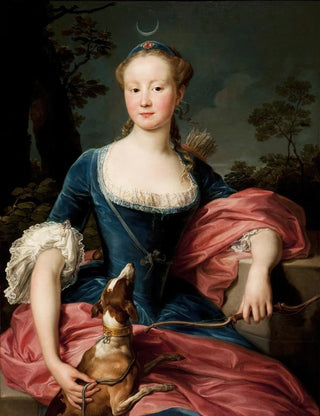Art print | Portrait of a lady as Diana the Huntress - Pompeo Batoni


View from behind

Frame (optional)
In the world of art, certain works transcend time and capture the very essence of beauty and grace. The "Portrait of a Lady as Diana the Huntress" by Pompeo Batoni is a striking example. This piece, created in the 18th century, embodies the spirit of rococo while evoking a rich and complex mythology. The depiction of a woman, noble and mysterious, dressed as Diana, the goddess of the hunt, invites us to explore a universe where femininity and power meet. Through this art print, the viewer is transported to a world where elegance and sophistication reign supreme.
Style and uniqueness of the work
Batoni's style is characterized by an exceptional mastery of colors and lights, which give his portraits remarkable depth and vibrancy. In this piece, the composition is carefully orchestrated, highlighting the graceful silhouette of the lady, draped in sumptuous fabrics that seem almost tangible. The meticulous details, from the ornaments of her attire to the delicate expressions on her face, demonstrate unparalleled craftsmanship. The color palette, oscillating between soft hues and luminous highlights, creates an atmosphere that is both serene and dynamic. This art print does not merely depict a female figure; it tells a story, that of a woman embracing her identity with strength and elegance, while fitting into a rich artistic tradition.
The artist and his influence
Pompeo Batoni, an emblematic figure of the 18th century, established himself as one of the most sought-after portraitists of his time. Originating from Lucca, Italy, he combined classical influences with stylistic innovations to create works of rare beauty. His approach to portraiture goes beyond simple representation; he aims to capture the soul of his subjects, immortalizing their essence in harmonious compositions. Batoni also played a crucial role in the evolution of European portraiture, influencing many artists who followed him. His ability to fuse mythological narration with contemporary portraits paved the way for a new way of conceptualizing art, making him

Matte finish

View from behind

Frame (optional)
In the world of art, certain works transcend time and capture the very essence of beauty and grace. The "Portrait of a Lady as Diana the Huntress" by Pompeo Batoni is a striking example. This piece, created in the 18th century, embodies the spirit of rococo while evoking a rich and complex mythology. The depiction of a woman, noble and mysterious, dressed as Diana, the goddess of the hunt, invites us to explore a universe where femininity and power meet. Through this art print, the viewer is transported to a world where elegance and sophistication reign supreme.
Style and uniqueness of the work
Batoni's style is characterized by an exceptional mastery of colors and lights, which give his portraits remarkable depth and vibrancy. In this piece, the composition is carefully orchestrated, highlighting the graceful silhouette of the lady, draped in sumptuous fabrics that seem almost tangible. The meticulous details, from the ornaments of her attire to the delicate expressions on her face, demonstrate unparalleled craftsmanship. The color palette, oscillating between soft hues and luminous highlights, creates an atmosphere that is both serene and dynamic. This art print does not merely depict a female figure; it tells a story, that of a woman embracing her identity with strength and elegance, while fitting into a rich artistic tradition.
The artist and his influence
Pompeo Batoni, an emblematic figure of the 18th century, established himself as one of the most sought-after portraitists of his time. Originating from Lucca, Italy, he combined classical influences with stylistic innovations to create works of rare beauty. His approach to portraiture goes beyond simple representation; he aims to capture the soul of his subjects, immortalizing their essence in harmonious compositions. Batoni also played a crucial role in the evolution of European portraiture, influencing many artists who followed him. His ability to fuse mythological narration with contemporary portraits paved the way for a new way of conceptualizing art, making him






